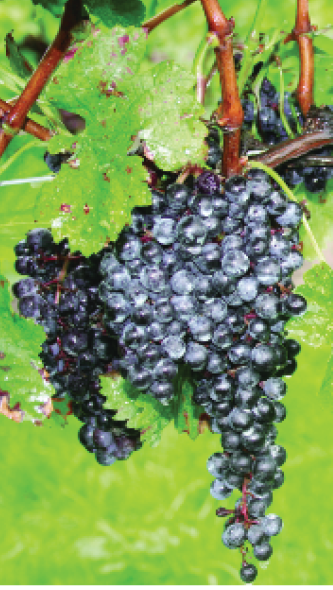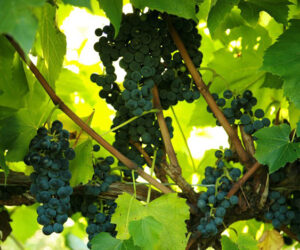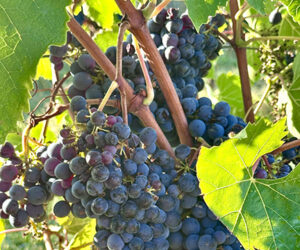
Is Merlot a bad grape or did it just get a bad rap? Back in 2004, the movie Sideways came out. The film was an adaptation of the book written by Rex Pickett, which followed two 40-something year old men on a “man-quest” in which one character was about to get married and wanted to have one last fling, the other, the main character Miles, was a divorced and opinionated wine snob who loved Pinot Noir and despised Merlot.
After the movie was released, many wine-connected folks decided that Merlot was “out” and Pinot Noir was “in.” Sideways was a high point for Pinot Noir, but a nightmare for Merlot. As we explore the world of Merlot, however, you will see how this grape was shaped into the Bordeaux blends and as a major component in other wines throughout the world. This noble grape of Bordeaux will never truly fall from grace; it will only age gracefully for the wine styles it produces.
Merlot is the most common grape variety grown in France, covering about 280,000 acres. It is most common in Bordeaux, Bergerac, and Cahors, but is also present in the south of France in the Languedoc, where it is a principle component in vins de pays wines. The Merlot grape is a principle historical component of Bordeaux blends along with Cabernet Franc, Cabernet Sauvignon, Malbec, and Petit Verdot. You will also find smaller plantings in the regions of Provence, the Loire Valley and other smaller appellations.
Elsewhere in Europe, Merlot is the fifth most widely planted grape in Italy, where it is a blending component with Sangiovese in what are known as the “Super Tuscans.” A bit to the northeast, it is one of the anchor components of Hungary’s Egri Bikavér, more commonly known as “Bull’s Blood,” where it is paired with Cabernet Sauvignon, Cabernet Franc, and the native Kadarka variety. Worldwide, Merlot is grown in all major wine growing regions and flourishes in cooler climates.
In the United States, it is marketed as a varietal, and the wines named for it must contain at least 75% percent of the grapes. It is also one of the varieties that can be used in the trademarked blend name “Meritage.” Some of the areas of California that support Merlot are the Sonoma and Monterey areas. Merlot is also grown in Oregon, and has become a significant anchor variety in eastern Washington State and on the East Coast, with plantings on Long Island, in Virginia’s Shenandoah Valley and Monticello, and also in the Niagara wine region of the US and Canada. In the southern hemisphere, Chile, Argentina, New Zealand and Australia account for a percentage of the overall domestic and worldwide market. About 15 years ago, a “white” version of Merlot emerged in the US marketplace and I had always thought this was a trend meant to try to tack on the heels of the White Zinfandel movement. However, White Merlot styles originate in Switzerland. Also, interestingly, winemakers have recently petitioned for Merlot to be included in the blends of Rioja in Spain.
With such widespread plantings and blend possibilities, you are invariably going to see differences in flavors and qualities, but quite frankly, as a reader of this issue, you learn that that’s the case with just about every grape variety in the world! Merlot, when optimally ripe, has a characteristic cherry, plum, cassis, blackberry, blueberry, and boysenberry flavor profile (although not all wines will exhibit every one of those descriptors). Vegetal characters, such as canned green beans, black olives and green bell peppers are dominant early in the maturation process after veraison. The challenge for a grower is getting the right conditions in the vineyard to properly mature the fruit. Sunlight is good, however, excessive heat will tend to rush the fruit; causing sugars to rise ahead of the metabolic maturation process that will mature the flavor profile in the berry.
Merlot grows best in cool climates with clay-like soil conditions. It often buds early in the spring, which makes it susceptible to frost dangers. The berries are generally large, depending on the clone and the growing conditions, and the clusters are loose in nature. As with most grape varieties, early or extreme northern or southern latitude harvests tend to produce wines with good acid structure, while those from the warmer regions of lower latitudes tend to be poor in acid structure. The grape is also known for its variable tannin structure. In the clay soils of Pomerol, France, for example, it tends to be more tannic than other areas of Bordeaux. In Napa Valley (in my experience), the grapes have a deep color and relatively softer tannin structure characteristic.
From a viticulture viewpoint, for Merlot as well as other varietals, there are some growers who believe that lower crop levels (less than 3 tons per acre) lead to higher quality fruit. There is not a lot of scientific evidence to support this, unfortunately. One study, as published in 2004 by Dr. Mark Matthews, from UC-Davis, concluded that, “Cabernet Sauvignon aromas and flavors respond to yield manipulation, but do so significantly only when yield is altered early in fruit development.”
This research goes against the prevailing mantra of crop adjustment post veraison, and thus was pretty controversial at the time. The study was done using Cabernet grapes, but the underlying principles of crop weight versus quality were vetted in a scientific forum. I’m the kind of winemaker who forever tries to see the merits of research and historical observations, and I really feel that the truth lies somewhere in the middle. If the growing season permits, the vine will do everything possible to ripen all its fruit. If there is a large crop to ripen, that process will take longer. The study was performed in California where long growing seasons are common, but a similar research plot on similarly fertile soil in the North American Pacific Northwest may have an entirely different outcome. The clay soils of the great vineyards of Bordeaux, for example, tend to self-regulate the amount of fruit set on the vine, and therefore quality is built into the grape model.
Whether or not because of Sideways, Merlot has somewhat fallen out of favor in recent years, which has taken a toll on Merlot growers. According to the annual grape crush report published by the California Department of Food and Agriculture, the statewide average per ton price in 2000 was $950; in 2010 it was $612. The total tons crushed in 2000 equaled 305,000 and in 2010 it was 243,000 — hardly a good day’s work, and in some cases, the growers are only breaking even or less. To the commercial winemaker, this means that there is now a source of fruit at bargain basement prices, but there’s the problem of selling the wine. Some winemakers use it as a blending grape, but this demand hardly dents the supply in the field.
To the home winemaker, however, this trend is a boon. Growers are increasingly interested in using the home winemaking market as an outlet for Merlot, and they are keeping prices down while maintaining quality in hopes that interest generated in the home winemaking market will help commercial Merlot bounce back. Invariably, the variety again will grow in popularity, but in the meantime, many Merlot vineyards are being converted to Cabernet. Therefore, the time is now for home winemakers to take advantage of this low point in the market — the variety will bounce back, but there will be reduced plantings, ultimately making it harder to get.
The maturity of the grape depends on the site of course, but I should point out that the optimal maturity of this variety generally occurs in a very short window . . . and the best wines are captured in that window. Too early a harvest and the green vegetal characters dominate, too late and the fruit presents a cooked appearance, and the resulting wines are one dimensional and excessively high in alcohol. While timing of harvest is the most important factor in high-quality Merlot, it is just as important for the winery to receive the fruit in a timely manner. This is something that should be the case with any winery and variety, but some varieties are more forgiving in the field than others.
Typical Merlot winemaking incorporates destemming and crushing the grapes. Lighter styles are pressed after seven to ten days of fermentation, while some winemakers may opt for an extended maceration to extract as much tannin as possible. Color in the grape is generally not a problem if the grapes are allowed to mature properly on the vine. Maximum color extraction generally occurs within ten days of maceration.
In my opinion, Bordeaux isolate yeast (Lallemand BDX) can help balance the wine and round out mouthfeel. Acidity adjustments are only necessary for grapes grown in the hottest of climates (which, as I mentioned earlier, is also an indicator that perhaps this isn’t the best fruit to use for making Merlot). Keep the press fractions separate during pressing and use the hard press for a later blend back to balance the tannins. While the grape is known to be light in tannin, some tannin structure is necessary to make the best wines. Aging in oak barrels adds roundness to the wine, as well as vanilla, cream, sweet and toast attributes.
Merlot pairs very well with beef, grilled veal, lamb and game birds, such as pheasant and wild turkey. Some of the lighter styles are described to pair well with shellfish. Traditional French cheeses also work well with Merlot, such as Camembert, Roquefort and Brie, making it a great appetizer wine. If these combinations sound like something you might find if you were sitting at a café in Bordeaux, then you’re right. Several hundred years of winemaking in France have helped shape this variety as well as the foods with which it has been traditionally served.
Merlot Recipe
Yield: 5 gal/19 L)
Ingredients
• 125 pounds (57 kg) fresh Merlot fruit
• Distilled water
• 10% potassium metabisulfite (KMBS) solution. Weigh 10 grams of KMBS, dissolve into about 50 milliliters (mL) of distilled water. When completely dissolved, make up to 100 mL total with distilled water.)
• 5 grams Lallemand BDX yeast EC-1118 (Lallemand, Scott Laboratories) or Premier Cuvée
• 5 grams Di-ammonium Phosphate (DAP)
• 5 grams Go-Ferm
• 5 grams Fermaid K (or equivalent yeast nutrient)
• Malolactic Fermentation Starter Culture (CHR Hansen or Equivilent)
Other equipment or needs
• 15-gallon (57-L) food-grade plastic ucket for fermentation
• 5-gallon (19-L) carboy, one or two 1-gallon (3.8-L) jugs
• Racking hoses
• Destemmer/crusher
• Wine press
• Ability to maintain a fermentation temperature of 85–90 °F (30–32 °C).
• Inert gas (nitrogen, argon or carbon dioxide)
• Thermometer capable of measuring between 40–110 °F (4–43 °C) in one degree increments.
• Pipettes with the ability to add in increments of 1 milliliter.
• Clinitest® tablets
• Tartaric acid
Step by step
1. Clean and sanitize all your winemaking tools, supplies and equipment.
2. Crush and destem the grapes. Transfer the must to the fermenter.
3. During the transfer, add 15 milliliters of 10% KMBS solution (This addition is roughly the equivalent of 50 ppm SO2). Mix well.
4. Take a sample to test for Brix, acidity and pH. Keep the results handy.
5. Layer the headspace with inert gas and keep covered. Keep in a cool place overnight.
6. The next day, suspend the Fermaid K in a little distilled water (usually ~ 20 mL). Add to must or juice once fermentation starts and mix well.
7. Go back to the lab results you took yesterday. Typical Brix for this style is 24-25 °Brix. Typical acid levels will be 0.65-0.70%. Adjust as necessary using tartaric acid. If the acid is higher than 0.70% don’t panic — this recipe calls for a minimum final acidity of 0.50%.
8. Prepare yeast: Heat about 50 mL distilled water to 108 °F (42 °C). Mix the Go-Ferm into the water to make a suspension. Take the temperature. Pitch the yeast when the suspension is 104 °F (40 °C). Sprinkle the yeast on the surface and gently mix so that no clumps exist. Let sit for 15 minutes undisturbed. Measure the temperature of the yeast suspension. Measure the temperature of the must. You do not want to add the yeast to your cool juice if the difference in temperature of the yeast and the must exceeds 15 °F (8 °C). Acclimate your yeast by taking about 10 mL of the must juice and adding it to the yeast suspension. Wait 15 minutes and measure the temperature again. Do this until you are within the specified temperature range. Do not let the yeast sit in the original water suspension for longer than 20 minutes. When the yeast is ready, add it to the fermenter and mix.
9. You should see signs of fermentation within one to two days.
10. You need will need to push the grapes back into the juice to promote color and tannin extraction. This is called “punching down” and this should be done three times per day.
11. Monitor the Brix and temperature twice daily during peak fermentation (10-21 °Brix). Morning and evening is best and more often if the temperature shows any indication of exceeding 85 °F (29 °C). Do not cool off to less than 80 °F (27 °C).
12. At about 19 °Brix, sprinkle in the DAP and punchdown.
13. When the Brix reaches zero or lower (about 5–7 days), transfer the must to your press and press the cake dry. Keep the press runs seperate for now.
14. Transfer the wine to your carboys or one-gallon (3.8-L) jugs. Make sure you do not have any head space. Place an airlock on the vessel(s). Label the vessels.
15. Measure the residual sugar using the Clinitest®. The residual sugar should be 0.5% or lower if the fermentation has proceeded to dryness as expected. If not, you need to complete fermentation.
16. Rack the wine off of the gross lees, then inoculate with your malolactic (ML) bacteria. Check the manufacturer’s instruction on how to prepare and inoculate. Cover the tops with an air lock to allow CO2 to escape.
17. Monitor the ML fermentation using a thin layer chromatography assay. Follow the instructions to complete MLF included in the kit.
18. Add 2 mL of fresh KMBS (10%) solution per gallon of wine, which is the equivalent to ~40 ppm addition.
19. Place wine in a cool place to settle.
20. Consider adding some French and/or American oak chips to your press fractions. Do not treat the entire lot of wine.
21. After two weeks, test for pH and SO2, adjust the SO2 as necessary based on your wine’s pH using the online sulfite calculator at www.winemakermag.com/guide/sulfite. Check the SO2 in another two weeks and adjust. Once the free SO2 is adjusted, maintain this level.
22. Rack the wine clean twice over six to eight months to clarify. Fine or filter if clarity problems are evident. Do not add sorbate if your residual sugar measurement is above 0.2%.
23. Once the wine is cleared, it is time to move it to the bottle (about 12 months).
24. Blend the oak fraction back into the free run as you like.
25. Filter (if you choose) and bottle. Check and adjust your free SO2 before bottling, and maintain sanitary conditions while bottling.






